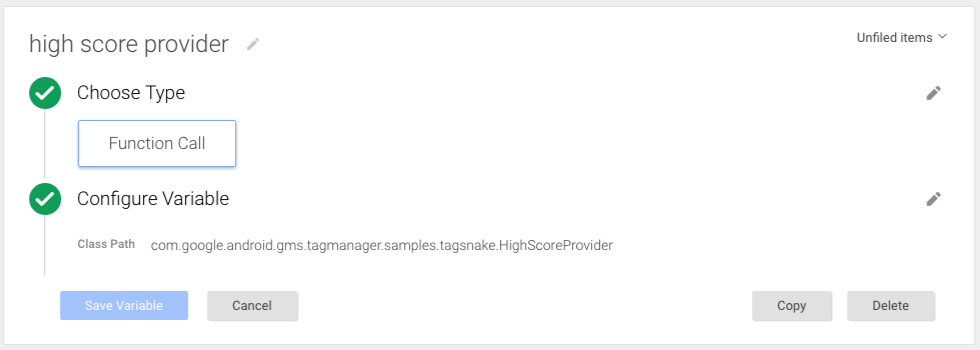Google Tag Manager की सुविधाओं को बेहतर बनाने के लिए, फ़ंक्शन कॉल वैरिएबल और फ़ंक्शन कॉल टैग जोड़े जा सकते हैं. फ़ंक्शन कॉल वैरिएबल की मदद से, पहले से रजिस्टर किए गए फ़ंक्शन के कॉल से मिलने वाली वैल्यू कैप्चर की जा सकती हैं. फ़ंक्शन कॉल टैग की मदद से, पहले से रजिस्टर किए गए फ़ंक्शन चलाए जा सकते हैं. उदाहरण के लिए, अतिरिक्त मेज़रमेंट और रीमार्केटिंग टूल के लिए हिट ट्रिगर करने के लिए, जो फ़िलहाल Tag Manager में टैग टेंप्लेट के साथ काम नहीं करते.
कस्टम टैग और वैरिएबल जोड़ना
फ़ंक्शन कॉल के साथ कस्टम टैग या कस्टम वैरिएबल जोड़ने के लिए:
ऐसी क्लास लागू करें जो
com.google.android.gms.tagmanager.CustomTagProviderयाcom.google.android.gms.tagmanager.CustomVariableProviderको एक्सटेंड करती हो:import android.support.annotation.Keep; import java.util.Map; @Keep public class HighScoreProvider implements com.google.android.gms.tagmanager.CustomVariableProvider { @Override public String getValue(Map<String, Object> map) { synchronized (HighScoreProvider.class) { return ((Long)sHighScore).toString(); } } private static long sHighScore = 0; public static void recordScore(long score) { synchronized (HighScoreProvider.class) { sHighScore = Math.max(score, sHighScore); } } }ProGuard का इस्तेमाल करने पर, पक्का करें कि क्लास के नाम और तरीकों को बदला न गया हो. इसे बताने के लिए Keep एनोटेशन का इस्तेमाल करें.
Google Tag Manager के वेब इंटरफ़ेस में, टैग और वैरिएबल सेट अप करने के लिए, पूरी तरह से सही क्लास के नाम का इस्तेमाल करें:

